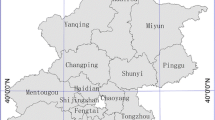Abstract
Land use change has become a new field in global change research, and it is closely related to land resource security and sustainable development. The environmental simulation model was mostly used to study the land-use change before. In this paper, we use the Economic Lorenz curve and Gini coefficient of economic model to study the land use structure changes in the western plain of Jilin Province, China. The results showed that the Lorenz curve has the phenomenon of “two near and two far” and Gini coefficient “two increased and two decreased”. That is to say, during the 15 years from 1989 to 2004, the areas of cultivated land and unused land had increased, Lorenz curves were near to the perfect equality line, and the distribution tended to be uniform; the areas of grassland and water body were reduced, the Lorenz curves were away from the perfect equality line, and the distribution tended to be increasingly uneven, which reflects the main process of the land use structure changes. Studying on the land use changes based on Economic model is simpler and more intuitionistic, and had the generalization values.
Similar content being viewed by others
References
Abdurrahman, G., & Ibrahim, B. (2008). Monitoring urban growth and detecting land-cover changes on the Istanbul metropolitan area. Environ Monitoring and Assessment, 136, 449–459.
Chen, Y. G., & Liu, J. S. (2001). An index of equilibrium of urban land-use structure and information dimension of urban form. Geographical Research, 20(2), 46–152.
Deng, Y., Wang, Z., Xiong, Y., Wan, L., Wu, J., & Song, X. (2002). The evolvement and estimation of urban structure of shanghai. Journal of Eastching Normal University (Natural Science), 2, 67–72.
Du, C., Lin, N.-F., & Tang, J. (2005). RS-GIS Integration research on land use dynamic changes in western plain of Jilin province. Journal of Jiling University (Earth Science Edition), 35(3), 366–372.
Egghe, L., & Rousseau, R. (2006). Classical retrieval and overlap measures satisfy the requirements for rankings based on a Lorenz curve. Information Processing & Managemeng, 42(1), 106–120 JAN.
Huang, Y.-F., Xu, C.-M., & Huang, Y.-J. (2003). Using Lorenz curve to analyze land use in Jiangxi province. Journal of Jiangxi Normal University (Natural Sciences Edition), 27(2), 177–180.
Jensen, J. R. (1996). Introductory digital image processing, A remote sensing perspective (2nd ed.). Upper Saddle River, NJ: Prentice-Hall.
Jiang, L.-G., Nie, X.-H., & Liu, E.-F. (2003). Analysis on the spatial structure of urban land use in Jinan City. Economic Geography, 23(1), 70–73.
Lin, N.-F., & Tang, J. (2003). Quaternary environmental evolution and desertification in north CHINA. Journal of Changchun University of Science and Technology, 33(2), 183–191.
Lin, N., Tang, J., Bian, J. M., & Yang, J. Q. (1999). The quaternary environmental evolution and the problem of desertification in northeast plain. Quaternary Sciences, 5, 448–455.
Liu, Y. (1999). Family models used in optimal allocation of regional land use. Progress in Geography, 18(3), 26–31.
Liu, Y.-B., Chen, Z., & Yang, Y.-M. (2004). Study on the driving forces of changing the urban land-use spatial structure basing on information entropy in Wuhan. Resource Development & Market, 20(5), 335–337.
Liu, Q., & Ou, M.-H. (2005). The forecast of land use structure based on Markov process—A case study of Kunshan City. Journal of Nanjing Agricultural University, 28(3), 107–112.
Liu, X., & Wu, Q. (1999). Correct applying Lorenz curve and gini coefficient to regulate income and distribution. Journal of Bingtuan Staff Members University, (4), 5–7.
Luo, Y. (2005). Survey resident income gap by Gini coefficient. Statistical Outlook, (6), 89–90.
Ran, S.-H., & Lu, C.-H. (2006). Environmental impact assessment of the land use change in China based on ecosystem service value. Environmental Science, 27(10), 2139–2144.
Sun, X., & Liu, W.-K. (2005). Realization and demonstration of optimum allocation of land use structure. Journal of Pingdingshan Institute of Technology, 14(2), 1–3.
Tang, J., Li, Z.-Y., & Lin, N.-F. (2006). Spatio-temporal variation of grassland in western songnen plain. Resources Science, 28(1), 63–69.
Xiong, J. (2003). Comparison and selection of four estimation of Gini coefficient. Commercial Research, (23), 123–125.
Yang, J., & Han, X. (2003). Effects of land use change on carbon storage in terrestrial ecosystem. Chinese Journal of Applied Ecology, 14(8), 1385–1390.
Yu, F., & Li, X. (2006). Land use change and eco-security assessment of Huangfuchuan watershed. Acta Geographica Sinica, 61(6), 645–653.
Author information
Authors and Affiliations
Corresponding author
Rights and permissions
About this article
Cite this article
Tang, J., Wang, X. Analysis of the land use structure changes based on Lorenz curves. Environ Monit Assess 151, 175–180 (2009). https://doi.org/10.1007/s10661-008-0258-x
Received:
Accepted:
Published:
Issue Date:
DOI: https://doi.org/10.1007/s10661-008-0258-x




